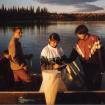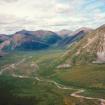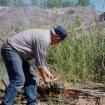Łiidląįį
This is one of the most picturesque places on the Arctic Red River. There are gravel bar deposits where the two rivers meet, and high eroding black shale cliffs with splashes of red, orange, green, purple, and yellow formed by the Arctic Red River flowing down from the east and the Cranswick River from the west. People climbed up into the mountains from here through an old time trail between the two rivers packing many loads ahead before making the actual journey to the mountains to reach their winter hunting grounds.




